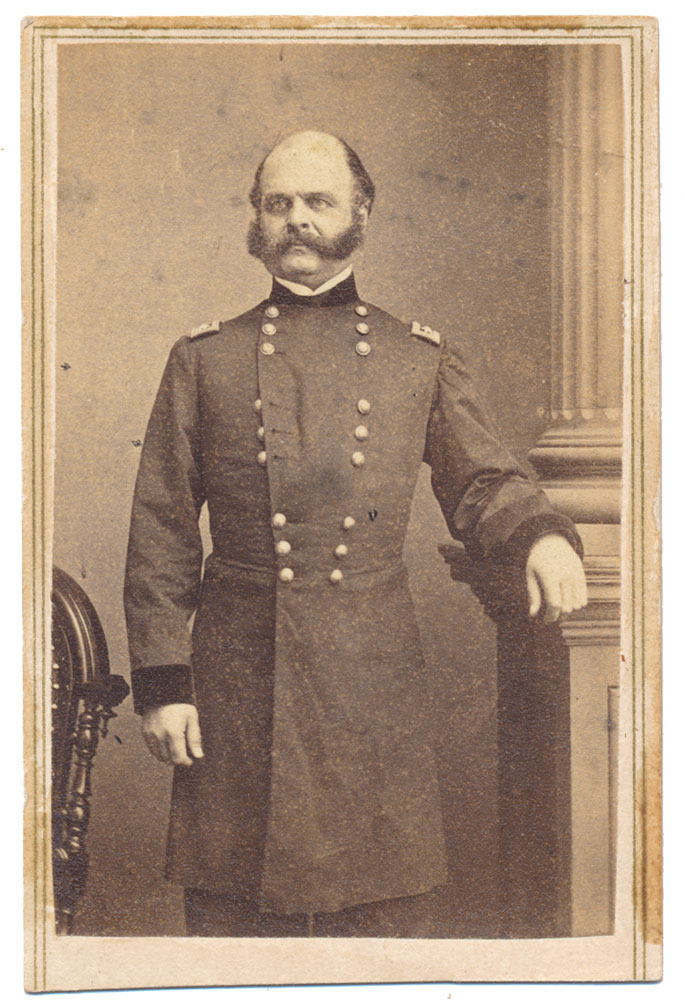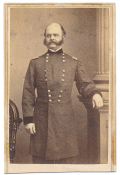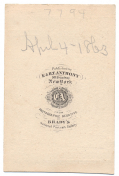site search
online catalog
FULL STANDING CDV OF MAJOR GENERAL AMBROSE BURNSIDE BY BRADY

$115.00 SOLD
Quantity Available: None
Item Code: 160-390
Full standing view of Burnside posed with one arm resting on the base of a column. He wears a dark double-breasted frock coat with black felt collar and cuffs and matching trousers.
Contrast and clarity are excellent. Bottom of mount is slightly trimmed. Paper is good.
Reverse has photographer’s imprint E. & H. T. ANTHONY…NEW YORK. FROM A BRADY NEGATIVE. Top has period pencil inscription of “APRIL 4, 1863.”
Ambrose Everett Burnside was born May 23, 1824 in Liberty, Indiana. He attended West Point and graduated 18th in the class of 1847. He was assigned to the 2nd US Artillery and went to Mexico where he arrived after hostilities ended. After his service in Mexico he served with the 3rd US Artillery in the west and in 1849 he was wounded by an arrow in his neck while fighting Apaches. In 1852 Burnside was assigned to Fort Adams in Newport, Rhode Island.
In October 1853, Burnside resigned his commission in the United States Army. Although maintaining a position in the state militia, he devoted his time and energy to the manufacture of the famous firearm that bears his name, the Burnside carbine. Then Secretary of War, John B. Floyd, contracted with the Burnside Arms Company to equip a large portion of the Army, mostly cavalry, with his carbine and induced him to establish extensive factories for its manufacture. The Bristol Rifle Works were no sooner complete than another gun maker allegedly bribed Floyd to break his $100,000 contract with Burnside.
Burnside then ran as a Democrat for one of the Congressional seats in Rhode Island in 1858 and was defeated in a landslide. The burdens of the campaign and the destruction by fire of his factory contributed to his financial ruin, and he was forced to assign his firearm patents to others. He then went west in search of employment and became treasurer of the Illinois Central Railroad, where he worked for, and became friendly with, one of his future commanding officers, George B. McClellan.
At the outbreak of the Civil War Burnside became Colonel of the 1st Rhode Island Infantry and upon joining McDowell’s army he was given command of a brigade which he led at 1st Bull Run. In August 1861 Burnside was promoted to Brigadier General. As a General he conducted successful campaigns in North Carolina (for which he was made a Major General in March of 1862) and East Tennessee, as well as countering the raids of Confederate General John Hunt Morgan, but suffered disastrous defeats at the Battle of Fredericksburg in December of 1862 and Battle of the Crater in July of 1864. Burnside was plagued throughout his career by weak decision making and poor staff work. He eventually resigned from the army after Lee’s surrender at Appomattox.
After his resignation, Burnside was employed in numerous railroad and industrial directorships, including the presidencies of the Cincinnati and Martinsville Railroad, the Indianapolis and Vincennes Railroad, the Cairo and Vincennes Railroad, and the Rhode Island Locomotive Works.
He was elected to three one-year terms as Governor of Rhode Island, serving from May 29, 1866, to May 25, 1869.
Burnside was a Companion of the Massachusetts Commandery of the Military Order of the Loyal Legion of the United States, a military society of Union officers and their descendants, and served as the Junior Vice Commander of the Massachusetts Commandery in 1869. He was commander-in-chief of the Grand Army of the Republic from 1871 to 1872, and also served as the Commander of the Department of Rhode Island, GAR. At its inception in 1871, the National Rifle Association chose him as its first president.
In 1875 Burnside was elected by the Rhode Island Senate as a U.S. Senator from Rhode Island and was re-elected in 1881 and served until his death. During that time, Burnside, who had been a Democrat before the war, ran as a Republican, playing a prominent role in military affairs as well as serving as chairman of the Foreign Relations Committee in 1881.
Burnside died suddenly of "neuralgia of the heart" at Bristol, Rhode Island on September 13, 1881. He is buried in Swan Point Cemetery, Providence, Rhode Island. [ad] [ph:L]
~~~~~~~~~~~~~~~~~~~~~~~~~~~~~~~~~~~
THIS ITEM, AS WITH ALL OTHER ITEMS AVAILABLE ON OUR WEB SITE,
MAY BE PURCHASED THROUGH OUR LAYAWAY PROGRAM.
CLICK HERE FOR OUR POLICIES AND TERMS.
THANK YOU!
Inquire About FULL STANDING CDV OF MAJOR GENERAL AMBROSE BURNSIDE BY BRADY
For inquiries, please email us at [email protected]
Most Popular
Historical Firearms Stolen From The National Civil War Museum In Harrisburg, Pa »
Theft From Gravesite Of Gen. John Reynolds »
Cavalry Carbine Sling Swivel »
Fine Condition Brass Infantry Bugle Insignia »
featured item
BREVET MAJOR GENERAL’S COMMISSION AND G.A.R. BADGE OF SAMUEL SPRIGG CARROLL: HIS TROOPS HELPED SAVE CEMETERY HILL ON JULY 2 AND TO REPULSE PICKETT ON JULY 3 AT GETTYSBURG
Carroll was a fighting general who acquired several nicknames from his red hair along with three wounds and a number of promotions and brevets for his service on the battlefield. He received several brevets for actions in individual battles: major… (2020-894). Learn More »




